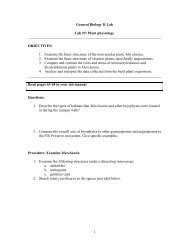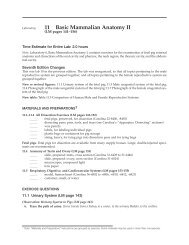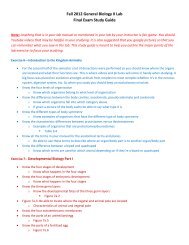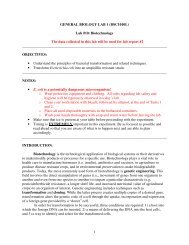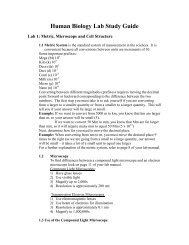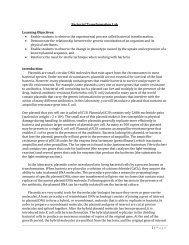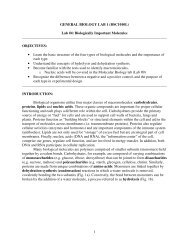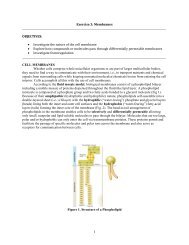GENERAL BIOLOGY LAB 1 (BSC1010L)
GENERAL BIOLOGY LAB 1 (BSC1010L)
GENERAL BIOLOGY LAB 1 (BSC1010L)
Create successful ePaper yourself
Turn your PDF publications into a flip-book with our unique Google optimized e-Paper software.
3. Based on the results of all groups, record the optimal temperature for amylase<br />
activity as well as the time for 100% hydrolysis to occur at the optimal<br />
temperature in the last two rows of each log file.<br />
IV. For homework:<br />
1. Calculate the mean and standard deviation (SD) for each temperature and time for<br />
both enzymes. Record these values in the log files.<br />
2. Using the numerical data collected in Tables 2 and 3, create a graph(s) in Excel that<br />
addresses the following questions:<br />
a. How does temperature affect amylase activity<br />
i. You may choose to plot either starch or maltose concentration but<br />
make sure that you understand the relationship between the two<br />
compounds..<br />
b. Is starch catabolism equally efficient across all temperatures<br />
c. Do fungal and human amylases breakdown starch at the same temperature(s)<br />
and rate (time to completely hydrolyze starch)<br />
d. What is the relationship between starch and maltose concentrations during<br />
starch hydrolysis<br />
3. Suggestions for graphing data:<br />
a. There is more than one way to present your data graphically. Each graph<br />
generated may show different aspects of your data and may explain the<br />
relationships between your variables in different ways. The key to figuring out<br />
the best way to show a particular relationship is by plotting the data and trying<br />
to interpret what the graph illustrates (you may need to plot the data using<br />
multiple approaches).<br />
b. You do not need a separate graph to answer each of the questions above but<br />
you may need to generate more than one graph to address the questions<br />
properly.<br />
c. When plotting your data, label the axes with a few words describing what is<br />
being measured and include units in parentheses [e.g. Time (min)]. Also<br />
remember to include a title for your graph.<br />
d. If you are plotting more than one variable on a graph, use different colors,<br />
symbols, or line patterns to differentiate between variables and create a legend<br />
to explain what each color/symbol represents.<br />
4. Questions to consider when examining your data<br />
a. Is there a lot of variation between the group data for each time, temperature<br />
and amylase type<br />
i. What can account for this variation (Hint: consider methodology and<br />
experimental errors)<br />
b. Is there more variance for certain temperature treatments than for others If<br />
so, what factors can explain the variance observed<br />
c. What does your data suggest about the optimal temperatures for amylase from<br />
the two different sources<br />
i. What about the time for hydrolysis<br />
15



